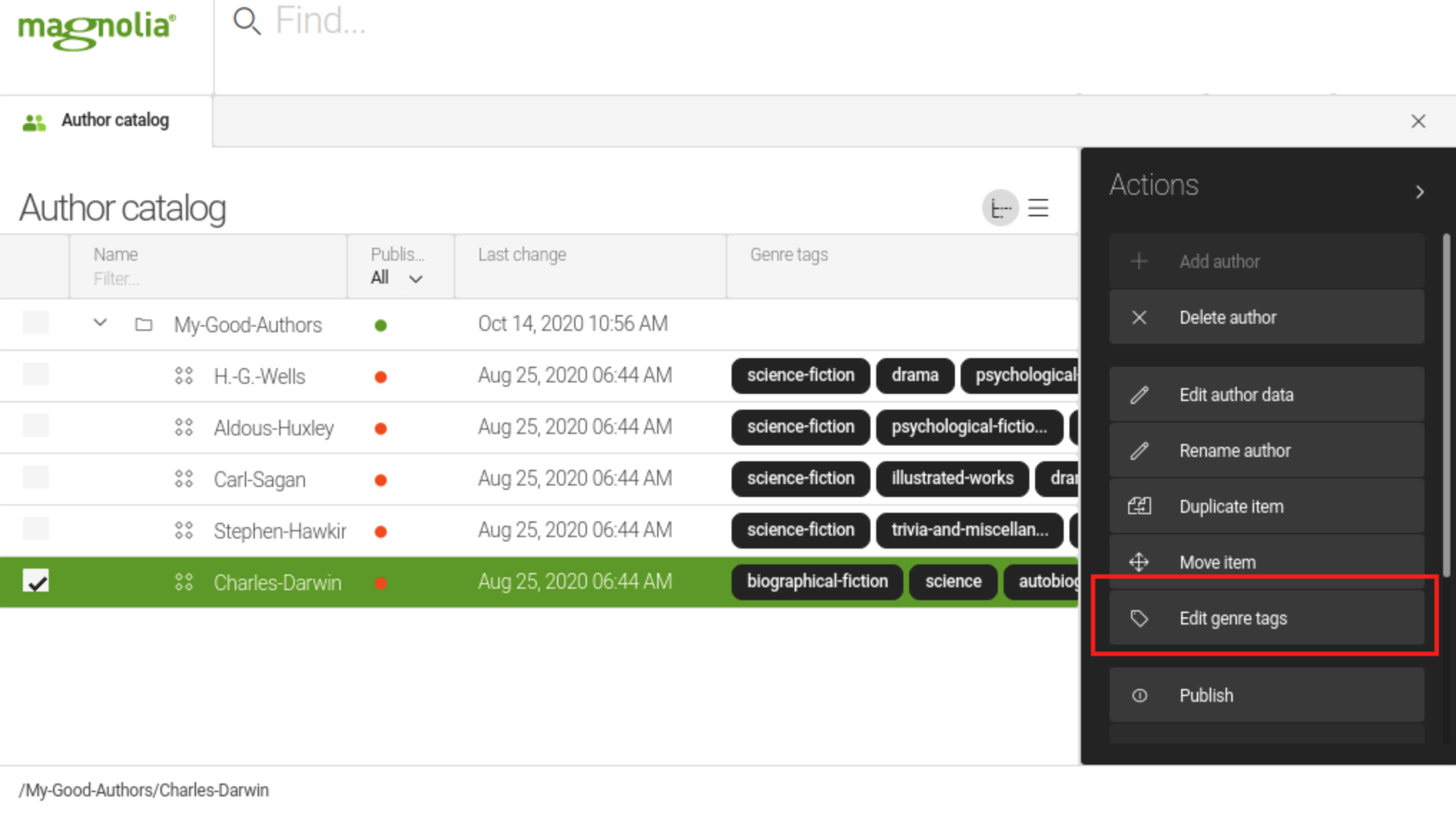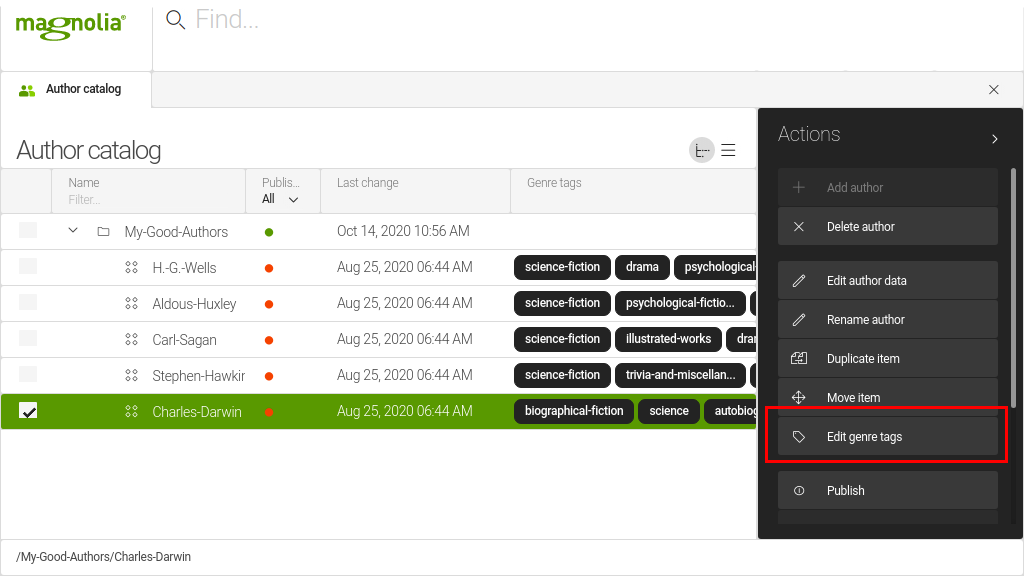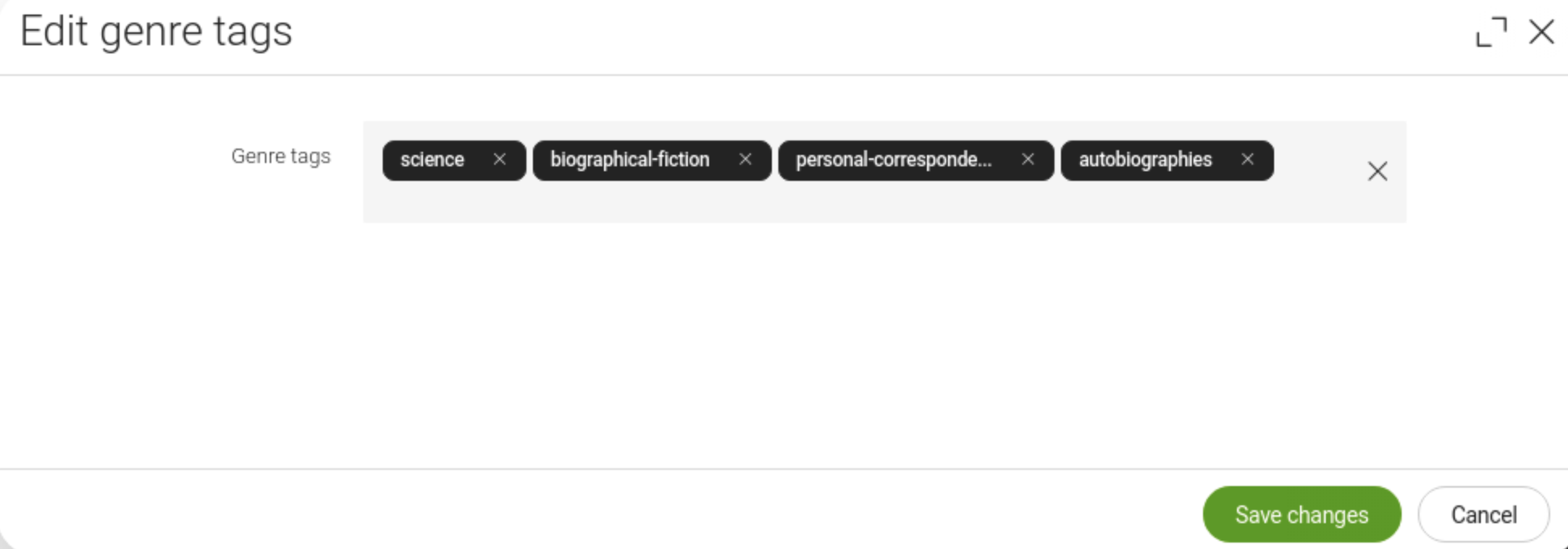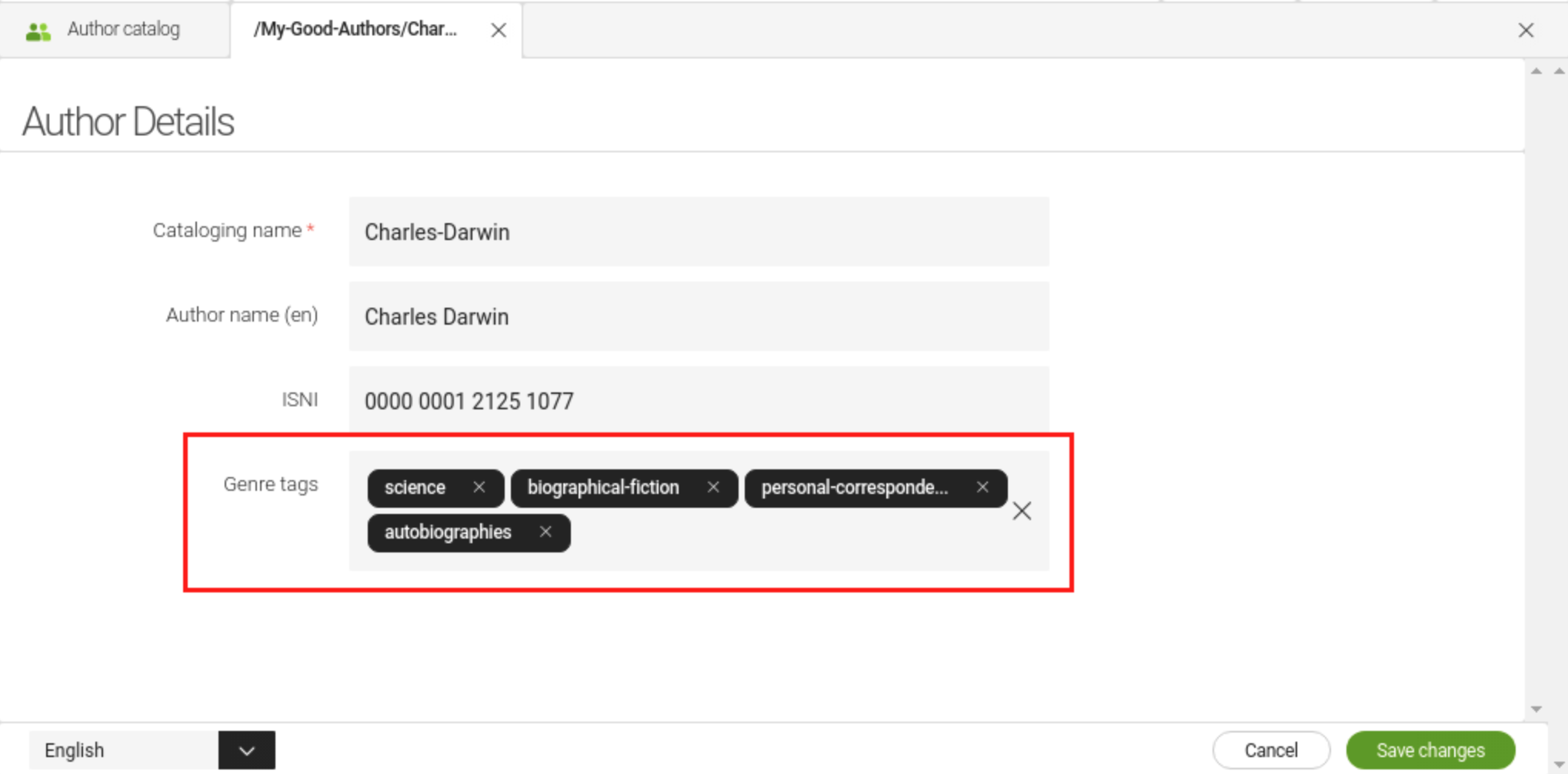How to enable content tags for a content app
This page explains how to enable content tagging in a content app so that authors can add tags to content items. Content tagging can be enabled in a new content app or in one that already exists.
The configuration code snippets displayed in the examples on this page
are based on content tagging configuration applied to the Authors app
which is part of our demonstration bookshelf module. You can clone the
module with this command:
git clone -b withAuthorCatalog https://bitbucket.org/magnolia-cms/bookshelf.gitIn an existing content app, you can also use definition decoration to enable content tagging.
Content tags can be edited:
-
In the browser subapp of your app.
-
Through a dedicated tags field (
info.magnolia.contenttags.ui.field.TagsFieldDefinition) in the detail view of a content item. -
Using the Tags app. To be able to do this, you need to register the app’s workspace in the configuration of the
content-tags-coremodule. Registering it there ensures that dependencies are managed across workspaces.
Before you start customizing your app, make sure your bundle contains
the Content tags
module’s magnolia-content-tags-core and magnolia-content-tags-ui
submodules. The third submodule,
magnolia-content-tags-ui-compatibility, is not mandatory. It only
handles 5 UI configurations in Magnolia 6 UI. If you wish to create or
modify a 5 UI definition for content tagging, see the
How
to enable content tags for a content app - 5 UI page.
Adding a tags column to the browser subapp
Configure a new column to display content tags in the browser subapp of
your app. Add the following tree and list content view
configurations to the workbench node of the browser subapp of your
content app descriptor:
contentViews:
tree:
columns:
tags: &tags
name: mgnl:tags
$type: columnComponent
type: java.util.Collection
editor:
field:
$type: tokenField
comboBox:
datasource:
$type: jcrDatasource
workspace: tags
allowedNodeTypes:
- mgnl:tag
list:
columns:
tags: *tags
Configure an i18n property to assign a custom title to the tags column.
The property’s name would be <app-name>.browser.views.mgnl-tags.label
and its value is in this case set to Genre tags.
Use an i18n message bundle for all i18n labels or descriptions of your content app.
Creating a dialog definition for tag editing
To edit a content item’s tags directly in the app’s browser subapp, you need to create a new action for the subapp and a dialog that will be called when you click that action.


First, create the dialog definition and add it to the dialogs folder
of your module. In this example, the dialog’s name is modifyTags.yaml:
form:
properties:
- name: mgnl:tags
class: info.magnolia.contenttags.ui.field.TagsFieldDefinition
actions:
cancel:
$type: closeAction
availability:
multiple: true
commit:
class: info.magnolia.contenttags.ui.form.action.AddTagsActionDefinition
availability:
multiple: true
footerLayout:
$type: defaultEditorActionLayout
primaryActions:
cancel: cancel
commit: commitThe dialog’s ID will be <module-name>:modifyTags.
Adding edit tag action to the action bar
Add the following actions and actionbar definitions to the browser node in the app descriptor of your app.
actions:
addTags:
class: info.magnolia.contenttags.ui.dialog.OpenTagDialogActionDefinition
actionbar:
sections:
item:
groups:
editActions:
items:
addTags:
name: addTagsAgain, use an i18n property in a message bundle to set the new action’s
label, for example
<app-name>.browser.actions.addTags.label=Edit genre tags.
Alternatively, a dialog for editing content tags
already exists in the content-tags-integration module. You can use it
in your app by referencing its ID. Below, the change can be seen on line
4. The i18n keys for the labels in this dialog will be different,
though.
|
actions:
addTags:
class: info.magnolia.contenttags.ui.dialog.OpenTagDialogActionDefinition
actionbar:
sections:
item:
groups:
editActions:
items:
addTags:
name: addTagsAdding a field for tag editing to the detail subapp
To edit content tags through a dedicated field in the detail subapp of
your app, add the following section to the properties node of the
detail subapp’s form definition:
mgnl:tags:
class: info.magnolia.contenttags.ui.field.TagsFieldDefinitionThis definition will create a field where users can edit content tags attached to the content item:

Register the content app workspace as a taggable workspace
You must register the content app workspace as a taggable workspace to ensure JCR data sanity and improve user experience. Registering it also ensures that when you rename or delete a tag in the Tags app, the system:
-
Checks for occurrences of these tags in registered workspaces.
-
Shows notifications about these occurrences.
-
Updates or removes the references of the tags on content items in registered workspaces.
To register the workspace, you can do one of the following:
-
If you use light development, decorate your light module:
Example: /decorations/content-tags-core/modules/config.yamltagableWorkspaces: dam: appMapping: app:dam:jcrDetail workspace: dam -
For the Authors app example, add a node to
/modules/content-tags-core/config/tagableWorkspacesusing the Configuration app:Table 1. /modules/content-tags-core/config/tagableWorkspaces Node name Value ⸬ tagableWorkspaces
⸬ mappings
⬩ appMapping
app:authors-app:detail
⬩ workspace
authors
Properties
| Property | Description | ||
|---|---|---|---|
|
required The root node for registration of content dependencies.
|
||
|
required Arbitrary name to register one workspace as taggable. |
||
|
required Use this pattern When a user clicks on a link to a tagged item, this defines which view of the item opens. |
||
|
required The name of the workspace of a content app. |